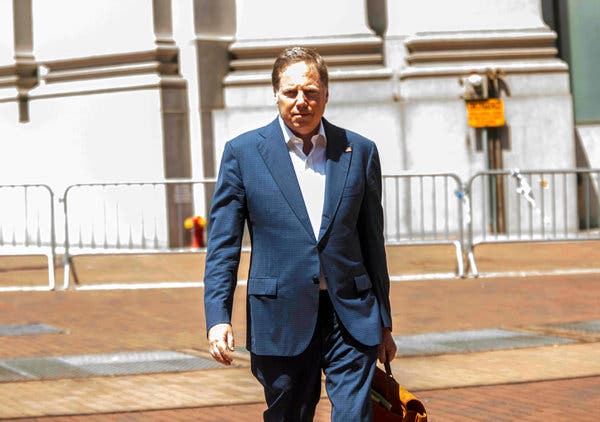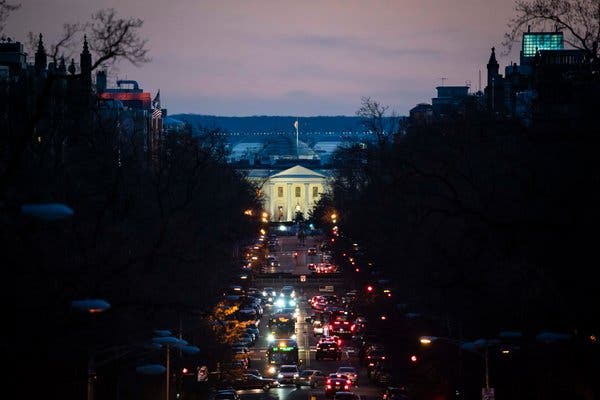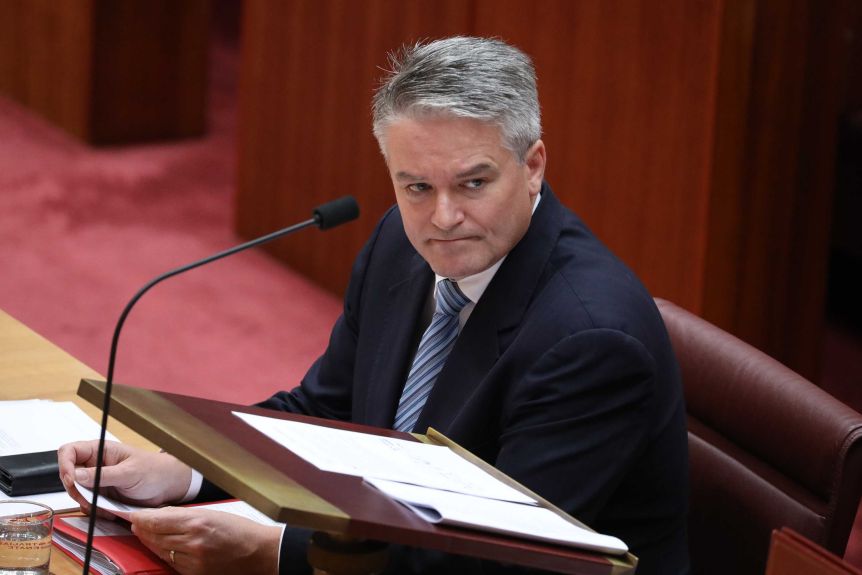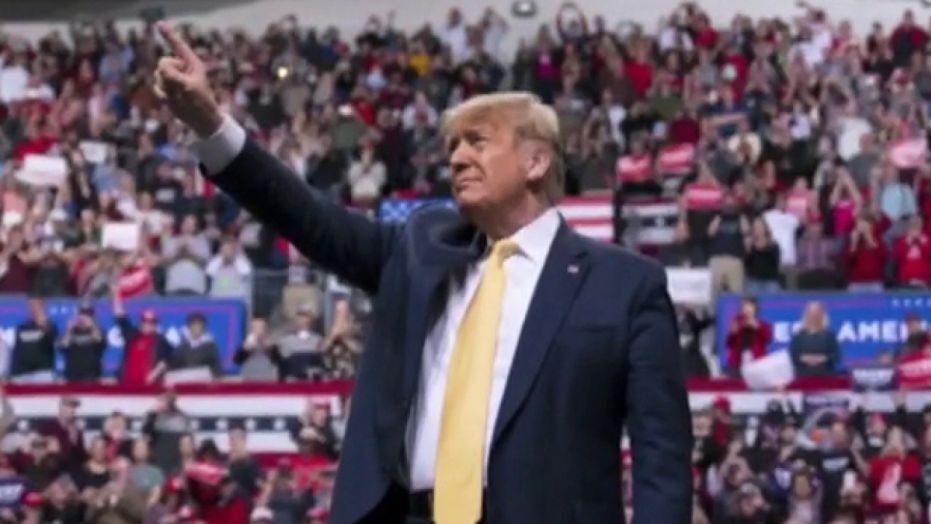Advertisement
The top federal prosecutor in Manhattan had refused to let the attorney general fire him, but acquiesced after William P. Barr invoked the president.

WASHINGTON — The declaration by the top federal prosecutor in Manhattan on Friday night that he would stay in his job despite Attorney General William P. Barr’s attempt to fire him raised not just the mystery of what was behind Mr. Barr’s move, but also a legal question: Who has the authority to remove him?
No definitive and settled Supreme Court precedent exists to look to for guidance, and federal statutes appear to conflict on the question. That set up the possibility of a protracted fight in court until Mr. Barr told the U.S. attorney, Geoffrey S. Berman, on Saturday that the president had fired him, and he acquiesced.
Legal experts had pointed to a 1979 Justice Department opinion to suggest that the ultimate result of any courtroom confrontation was likely to be that Mr. Trump — though not Mr. Barr — did have the authority to fire Mr. Berman.
“It’s probably the case that Trump, but not Barr, would have to remove Berman and take the political responsibility for doing so,” said Martin S. Lederman, a Georgetown University law professor who served in the Justice Department’s Office of Legal Counsel in the Obama administration, before the rapidly evolving dispute was resolved.
The Trump administration swiftly adopted that same interpretation as it sought to quash the show of defiance. In a letter to Mr. Berman, Mr. Barr wrote, “Because you have declared that you have no intention of resigning, I have asked the president to remove you as of today, and he has done so.”
Mr. Trump further confused matters by then telling reporters that he was “not involved” in Mr. Berman’s firing and that it was up to the attorney general. But Mr. Barr had also backed down on installing someone other than Mr. Berman’s deputy, Audrey Strauss, as his successor, and Mr. Berman essentially declared victory and said he would depart rather than pressing for greater clarity.
The whirlwind sequence — which began when Mr. Barr issued a statement Friday night falsely saying that Mr. Berman had stepped down and noting that he was appointing the U.S. attorney for New Jersey as his temporary successor — put a brief but intense focus on the question of who had legitimate authority to fire him.
Normally, under the Constitution, the power to remove government officials rests with whoever appointed them, except in instances where Congress set up an alternative mechanism. At issue is how that framework applies to the position of a U.S. attorney who was appointed by a court, as Mr. Berman was in 2018.
While the president appoints most U.S. attorneys following Senate confirmation, a law permits an attorney general to appoint a prosecutor to fill those vacancies for 120 days. If that temporary appointment expires, judges can fill it. A prosecutor appointed by the court will “serve until the vacancy is filled,” the statute says.
That is how Mr. Berman became U.S. attorney. He was initially appointed by the attorney general at the time, Jeff Sessions, and federal judges in Manhattan reappointed him after the 120-day period expired. In his statement Friday night, Mr. Berman indicated that Mr. Barr could not fire him because he had been appointed by the court, and declared he intended to remain in office until the Senate confirms a successor.
However, another federal law says that U.S. attorneys may be removed by the president. On its face, it makes no exception for those appointed by courts. That raises the question of whether Congress has established that presidents may remove prosecutors appointed by courts.
In 1979, during the Carter administration, the Justice Department’s Office of Legal Counsel, which analyzes legal issues for the executive branch, looked at this question. It concluded that the president — but not the attorney general — could fire such an official.
In a memorandum opinion, John M. Harmon, the head of the office at the time, cited the law that says presidents may fire U.S. attorneys. The law’s broad wording makes sense, he wrote, only if it is applied not just to presidentially appointed U.S. attorneys “but also is to be read as extending to ‘each’ U.S. attorney, including the court-appointed ones whom the president could not remove without congressional leave.”
Mr. Barr, in his letter on Saturday, cited that law, saying “it is well-established that a court-appointed U.S. attorney is subject to removal by the president.”
Mr. Harmon also pointed to constitutional arguments to back his conclusion: U.S. attorneys exercise executive power, making the president responsible for the conduct of their offices, so the president “must have the power to remove one he believes is an unsuitable incumbent, regardless of who appointed him,” he wrote.
In addition, Mr. Harmon wrote in 1979, it might violate constitutional protections for due process of law if judges overseeing cases as neutral arbiters had the power to fire prosecutors if the judges did not like how they handled their responsibilities.
Office of Legal Counsel opinions are generally considered to be binding interpretations of the law for Justice Department officials, but they are not legal precedents in the sense of judicial opinions by appeals courts or the Supreme Court.
The 1979 opinion pointed to one district court opinion from 1963 — also in Manhattan — which expressed the view that a president may remove a court-appointed prosecutor.
In his letter, Mr. Barr also pointed to a 2000 opinion by the federal appeals court in Boston that took the same position in passing, saying that a “president may override the judges’ decision and remove an interim United States attorney.” That is not dispositive, however, because that court does not oversee New York and its expression of that view was a tangential remark rather than a decision about the issue before the judges.
Even assuming that view is the correct interpretation of the law, Mr. Barr overstepped by trying to oust Mr. Berman on his own. Kelly T. Currie, a former acting U.S. attorney in Brooklyn, said Mr. Berman had “called the attorney general’s bluff” because only the president, not Mr. Barr, had the power to remove him.
“It’s telling that Berman’s statement following Barr’s attempt to oust him by press release explicitly defended ongoing investigations in that office,” Mr. Currie said, adding, “It’s hard not to suspect that Barr’s move is anything but an effort to thwart investigations that could be damaging to the president or his associates.”
In his letter, Mr. Barr suggested he was simply trying to give Mr. Berman an opportunity to take a different position or resign when he falsely announced a night earlier that Mr. Berman had stepped down. Mr. Barr also rejected the suggestion that his move was a bid to torque any cases, and asked the department’s independent inspector general to monitor any complaints of interference.
One other question was raised by the events: If Mr. Berman was ousted, who had the power to appoint someone other than his deputy to fill the vacancy while the Senate considers Mr. Trump’s nominee — Mr. Barr, as he purported to do on Friday night, or the court?
That could be particularly important because there is reason to believe that the Senate will not confirm Mr. Trump’s nominee for the position, Jay Clayton, the chairman of the Securities and Exchange Commission, who has no prosecutorial experience. Senator Lindsey Graham, Republican of South Carolina and the chairman of the Judiciary Committee, said on Saturday that he would not move the nomination without the assent of New York’s two Democratic senators.
Complicating matters, Mr. Lederman said, is that it is far from clear that the Trump administration can unilaterally install a different temporary successor to lead the office, as Mr. Barr had initially planned to do.
In 1986, when Samuel A. Alito Jr., now a Supreme Court justice, worked at the Office of Legal Counsel, he wrote a memorandum suggesting the attorney general could not make successive interim appointments. Still, in 1987, Charles J. Cooper, then the head of the office, wrote in another memo that “it could be argued” that after a president removed a court-appointed U.S. attorney, the power to appoint an interim successor reverted to the attorney general.
“It’s not at all clear that either Trump or Barr — as opposed to the court — could name Berman’s temporary replacement,” Mr. Lederman said.
In 1979, Mr. Harmon acknowledged some ambiguity even about who could fire a court-appointed U.S. attorney in the first place. He left open the possibility that district court judges might interpret the conflicting statutes in a way that was more favorable to their own powers rather than the president’s.
Mr. Harmon warned that just because he believed Mr. Carter could remove a court-appointed U.S. attorney did not necessarily mean it would be a good idea “since the incumbent U.S. attorney apparently has the backing of the district court. That court might react unfavorably to any action that does not carefully comport with the letter of the statute.”
But Mr. Berman’s decision to leave rather than contest his dismissal further appeared likely to sidestep such a confrontation over the legitimacy of his own departure.
William K. Rashbaum contributed reporting from New York.



